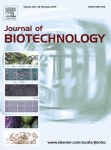Ver ítem
- xmlui.general.dspace_homeCentros e Institutos de InvestigaciónCICVyA. Centro de Investigación en Ciencias Veterinarias y AgronómicasInstituto de BiotecnologíaArtículos científicosxmlui.ArtifactBrowser.ItemViewer.trail
- Inicio
- Centros e Institutos de Investigación
- CICVyA. Centro de Investigación en Ciencias Veterinarias y Agronómicas
- Instituto de Biotecnología
- Artículos científicos
- Ver ítem
Trans-complementation of polyhedrin by a stably transformed Sf9 insect cell line allows occ− baculovirus occlusion and larval per os infectivity
Resumen
Oral infection of insect larvae with baculovirus is an advantageous methodology for producing high levels of recombinant proteins and for achieving plague control. However, many recombinant baculoviruses express a foreign protein in lieu of the polyhedrin and hence do not form occlusion bodies (occ−), resulting in extremely reduced per os infectivity in larvae. To overcome this limitation, stably transformed insect cell lines expressing polyhedrin capable
[ver mas...]
Oral infection of insect larvae with baculovirus is an advantageous methodology for producing high levels of recombinant proteins and for achieving plague control. However, many recombinant baculoviruses express a foreign protein in lieu of the polyhedrin and hence do not form occlusion bodies (occ−), resulting in extremely reduced per os infectivity in larvae. To overcome this limitation, stably transformed insect cell lines expressing polyhedrin capable of occluding occ− recombinant baculovirus by trans-complementation were developed to obtain oral inoculum for insect larvae infection. First, the optimum regulatory region of polyhedrin promoter was determined utilizing chloramphenicol acetyl transferase (CAT) as the reporter gene. After infection with occ− baculovirus, the higher expression levels of CAT were achieved when a region of 2735 bp that contained sequences known to have transcriptional enhancer functions were present upstream the polyhedrin coding sequence. This regulatory region was selected to drive polyhedrin expression in insect cell lines. Transfection of Sf9 cells with plasmid carrying polyhedrin gene and stable cell lines established by selection with blasticidin showed polyhedrin expression and, moreover, crystalline polyhedron-like structures were visualized by optic microscopy. Oral infectivity was demonstrated by fluorescence detection in Rachiplusia nu larvae infected with occluded AcGFPpolh− baculovirus obtained using the system presented here.
[Cerrar]

Autor
López, María Gabriela;
Alfonso, Victoria;
Carrillo, Elisa Cristina;
Taboga, Oscar Alberto;
Fuente
Journal of Biotechnology 145 (2) : 199-205 (January 2010)
Fecha
2010-01-15
Editorial
Elsevier
ISSN
0168-1656
Formato
pdf
Tipo de documento
artículo
Palabras Claves
Derechos de acceso
Restringido
 Excepto donde se diga explicitamente, este item se publica bajo la siguiente descripción: Creative Commons Attribution-NonCommercial-ShareAlike 2.5 Unported (CC BY-NC-SA 2.5)
Excepto donde se diga explicitamente, este item se publica bajo la siguiente descripción: Creative Commons Attribution-NonCommercial-ShareAlike 2.5 Unported (CC BY-NC-SA 2.5)

